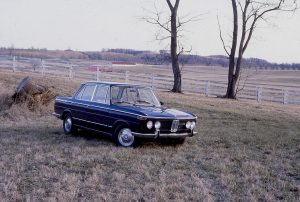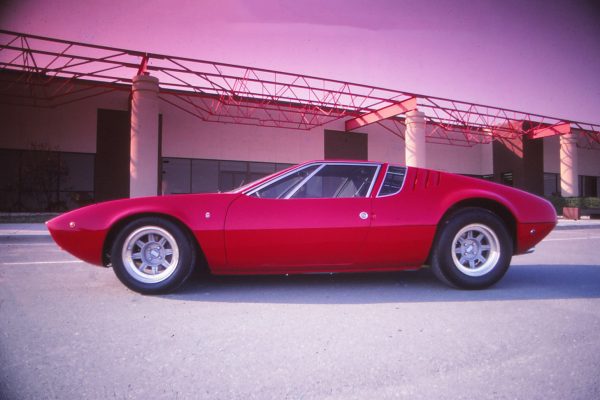Originally published in Road & Track Sport and GT Cars 2000

Celebrity status carries a terrible burden. Ask any Prowler driver. It’s almost impossible to go about one’s daily business without the delay caused by people asking everything from how fast will it go to what is it? After more than two years of production, the Plymouth Prowler still attracts attention and still draws a crowd. And still there are people who will say, “Wow, I’ve never seen one of these before!”
Since Plymouth began assembly in July, 1997, only about 3500 copies of the world’s only production street rod have been sold. So lack of visibility is not particularly surprising, especially considering that most Prowlers probably don’t get daily use. And most people haven’t seen the car pictured here because, in genuine Prowler Silver, this is a 2000 Prowler. The color replaces the original purple in this year’s palette, which also includes Prowler Black and Prowler Red.
More than just another color, the 2000 Prowler sports a number of detail changes, commendable on a car that, really, could have remained unchanged with few complaints. For example, the Prowler’s ride was improved by replacing rubber bushings with cross-axis ball joints in the rear suspension lateral links. The reduced friction allowed engineers to reduce front spring rates by 10 percent and rear rates by 20 percent, and recalibrate the front and rear Koni shock absorbers as well. Ride was also improved by a new generation of Goodyear Eagle GST EMT run-flat tires designed specifically for the Prowler. New sidewall architecture softens a ride while a stickier compound on the fronts improves handling.
Prowler’s creature comforts were enhanced with a standard glare-reducing electrochromatic rear view mirror incorporating a micro-size trip computer that includes a compass, ambient temperature gauge, elapsed time and fuel mileage. Standard AutoVolume adjusts the audio based on the speed of the vehicle with separate settings for top-up and top-down use. The interior is dressed up with a chrome bezel and leather boot for the shifter, which now also has an illuminated gear indicator. In a rare concession to practicality, the fuel tank capacity was increased slightly to 12.2 gallons. Other details include next-generation airbags that deploy with less force, child-seat tether anchorage and shift-lock for the automatic transmission. And in a nod to greenness, the 2000 Prowler now is equipped with an onboard recycling vapor-recovery system.
The Prowler loses nothing of its cool with the changes, however. The rakish profile, narrow up front and wide at the rear from the “skinny-fat” tires, remains. The tires attract a lot of attention, not only the difference in size between the front and rear but also the massive 20-in. rear wheels. The rear tire size, an incredible 295/40R-20, doesn’t even roll off the tongue easily. Only a tire that huge could make the big 225/45R-17 fronts look small.
For a car that is so much about looks, the Prowler has a lot to look at. It leads with Lenoesque chin – particularly vulnerable to curves for careless head-in parkers – while regulation bumpers in discreet black flank a body-color grill. Tucked behind the grill are shock absorbers with coil-over springs operated by rocker arms from the exposed front suspension. Projector-beam headlamps cling to the sides of the body under transparent blisters which, on our test Prowler, had condensation inside.
The open pattern of the chromed alloy wheels show off the front and rear disc brakes. Up front the tires are covered by close-fitting cycle-type fenders that move with the wheels. The rear fenders are fixed, with most of the massive tires under the body. Rear suspension is comprised of multiple lateral upper links, lower A-arms and coil-over rebound-adjustable shock absorbers. There are anti-roll bars fitted at both front and rear. The Prowler’s rear is wide, with rear lights beveled into the rear fenders and baloney-sliced exhaust pipes flanking the radiator for the rear mounted transaxle.
After a power boost last year, the 2000 Prowler stays a lusty 253 BHP from an all-aluminum sohc 24-valve V-6. With the 10.0:1 compression ratio, unleaded premium is required. The engine fits snugly between the body side covers and under a long hood that doesn’t open particularly wide. Ahead of the radiator one can see the MIG-welded aluminum alloy frame. The body itself is constructed of bonded-and-riveted aluminum alloy panels with SMC fenders, quarter panels and fascias.
The use of lightweight materials, as well as its small size (overall length is only 165 in.), gives the roadster a curb weight of 2838 lb. With little to haul around, the V-6 accelerates the Prowler athletically. A sub- 15 second ¼ -mile is not exactly shabby, but compared to Corvettes running in the mid-13’s, well, choose your stoplight matchups accordingly. The huge tires, while mostly for show, guarantee traction. And what feels like a rather high stall speed for the torque converter means the V-6 is up into its powerband right off the line. There’s no need to power brake the Prowler. Just mash the right pedal and go.
Left to itself the standard automatic transmission will allow the engine to wind up closed to its maximum 6800 rpm before shifting, howling as it goes. Surely Prowler totters on the edge of legality anywhere there are anti-noise regulations. One could argue that the Prowler’s sonorous, if generous, exhaust note isn’t noise. It is ever-present, however, whether cruising at 70 mph on the highway or ambling down Main Street, and top up or down makes little difference in the amount of sound reaching the drivers ear. The transmission can be manually controlled with the standard AutoStick, which steps gear up or down by tipping the lever right or left. While the extra control is welcome – many observers may feel an automatic is wholly out of place in the roadster – AutoStick programming often results in hyper-solid thudding shifts when used at part throttle. On the other hand, the ease of downshifting and the great pipes present tremendous temptation to use the transmission to slow down, and just hear that fabulous burbling on the overrun.
Even though Billy Crystal says it’s better to look good than to feel good, the Prowler treats occupants rather well, particularly those under six feet tall. Any taller than that and one’s head rubs on the fabric top and the low opening of the side windows tend to limit side vision. Even those around 5’10” will have trouble seeing high-mounted traffic lights, the rear vision is great through the glass backlight (with rear defroster elements) and the rear three-quarter view is less restricted than it would appear to be. Going to the drive-up window at the bank, however, requires leaning down to see the teller. Give her your best James Dean impression and everything’s cool. It’s cooler than trying to get in or out. Doors that don’t open very wide, a high sill and the low roofline make entry and exit easy only for Chinese circus contortionists. Just stay cosseted in the leather buckets that fit like the pocket of a baseball glove and a comfortable for the long haul, er, cruise.
The top is a single-layer affair bringing all the noise penalties that involves, but it goes down easily with a few levers, buttons and clips, tumbling into a space under the rear carapace, the whole of which tilts rearward for the procedure. That’s also access to the trunk, such as it is. Perhaps one could toss in a thin garment bag, but forget a cooler or picnic basket. Those will ride only in the passengers lap or, if small, by the passenger’s feet in the limited foot well. There’s no room, only a bulkhead, behind the seats, though that’s where the standard CD changer rides. If you want to go touring with the Prowler, better plan on using the matching $5075 Prowler trailer (bought by about 25 percent of Prowler buyers, says Plymouth) for luggage or ship it ahead via FedEx.
With the top lowered, there’s more turbulence at highway speeds than in many convertibles, but it’s hardly severe. In sunny California you’ll rarely see a Prowler with the top up but during our test in more temperate Pennsylvania where it actually rains at times, the top proved to be leak-free and tight. Driving through a thunderstorm was as fun as jumping in puddles in your galoshes. Around 35 mph, deeper pools drowned the windshield, but higher speed the spray didn’t have time to get that high.
The ride may be improved for 2000, but it’s still far cushy. A drive in the Prowler will acquaint you with new bumps on a road you thought you knew well. The suspension does actually travel, and peering over the cowl you can see the front wheels move. There’s just a lot of road shock through the stiff tires and firm suspension, as well as a fair amount of cowl shake. It’s all better than it was back in 1997, but these are still the realities of a Prowler.
Another reality is that most Prowlers apparently see little daily use, and it’s no surprise. It’s unquestionably one of the world’s most impractical automobiles. On the other hand, it’s also one of the world’s coolest. So cool that shades ought to be standard equipment. But then onlookers would treat you even more like a celebrity.








What Do You Think?
You must be logged in to post a comment.